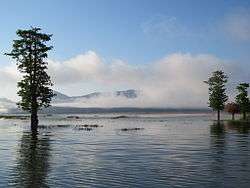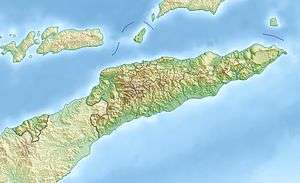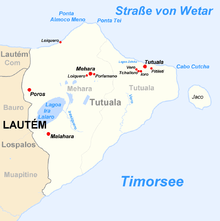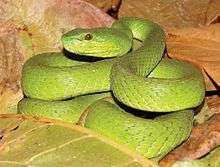Ira Lalaro
Lake Ira Lalaro (also Iralalaro, Ira-Lalaro, Surubec, Suro Bec) is a waterway in Mehara, Subdistrict Tutuala, Lautém District of East Timor.[1] It is the largest freshwater lake on the island of Timor,[2] and the largest lake in the country of East Timor.[3] The lake is part of the Mount Paitchau Important Bird Area.[4] The lake waters and that of Irasiquero River are a closed aquatic system; they lie within a huge polje. The surface water area fluctuations from 10–55 square kilometres (3.9–21.2 sq mi) while the authigenic catchment area measures 406 square kilometres (157 sq mi).[5]
| Lake Ira Lalaro | |
|---|---|
 Lake Ira Lalaro | |
 Lake Ira Lalaro | |
| Coordinates | 8°27′0″S 127°8′0″E |
| Primary outflows | Irasiquero River |
| Basin countries | East Timor |
| Max. length | 6.5 km (4.0 mi) |
| Max. width | 3 km (1.9 mi) |
| Surface area | Average 1.9 km2 (0.73 sq mi) |
| Surface elevation | 318 m (1,043 ft) |
| Settlements | Mehara, Malahara, Poros, Muapitine |
Geography and geology

Ira Lalaro is in the far east of Timor island, and is part of the Nino Konis Santana National Park (680 square kilometres (260 sq mi), which was established in August 2007 by East Timor.[6][7] The lake is located in a basin bounded by the Paitchau Mountains, within the Lospalos plateau. The region has karstic formations of limestone, with dolines, blind valleys, caves and springs. Ira Lalaro has an average water spread area of 1,900 hectares (4,700 acres), which varies from 1,000–5,500 hectares (2,500–13,600 acres). It is in a high plateau depression at an elevation of 334 metres (1,096 ft) "formed by a huge polje karst formation". The lake flows to the east and as the lake water recedes during the dry season the land exposed becomes a pasture or scrubby grassland.[8] The lake basin is surrounded by tropical dry forest which is of biodiversity value. The Irasiquero River, which originates from Lake Ira Lalaru, disappears in the main sink hole, the Mainina, about 3.5 kilometres (2.2 mi) downstream of the lake outlet, and does not re-appear; tracer studies indicate that the underground route of water flow leads to the coast. There are human settlements in the area.[5]
Biodiversity

The biodiversity of the lake's aquatic system, including the Irasiquero River, is that of a wetland ecosystem. The forest area is largely undisturbed.[5] In the absence of continuous surface water flow, the invertebrates found in the lake and in the river consist of macroinvertebrate belonging to 57 families but sans decapod crustaceans.[5] The Island pitviper (Trimeresurus insularis) and wood scorpions (Lychas mucronatus) are reported in the flood plains of the lake. Estuarine crocodiles (Crocodylus porosus) (about 300-350) are also found in the lake. It is not hunted by local people as it is their totem animal connected to their creation story and known as "lafaek" in the Tetum language. Boats are banned on the lake, based on a traditional belief that the fish in the lake will die when boats enter the water. Villagers were forced to stand in the water to fish, and fatal crocodile attacks were common. Recently fishermen appear to be using rafts to avoid crocodile attacks. The Timor snake-necked turtle (Chelodina mccordi timorensis) is also endemic to the lake and the river.[5] The local dialect name is ‘‘beo’’, the Tetum name is "lenok kakorok ular" and an alternative English name is Timor long-necked turtle. Chelodina mccordi is considered to be one of the 25 most endangered turtles in the world[9] and is protected under CITES Appendix II.[6] There are 21 fish species in the lake including an endemic species of hardyhead (Craterocephalus laisapi), found in the middle section of the Irasiquero River.[5][6]
The lake area has both migratory and resident water birds.[6] It is part of the Mount Paitchau and Lake Ira Lalaro Important Bird Area (IBA). One of globally threatened bird species reported is the yellow-crested cockatoo (Cacatua sulphur), which is considered critically endangered. Other species reported are: Australian pelican (Pelecanus conspicillatus), wandering whistling duck (Dendrocygna arcuata), common coot (Fulica atra), Swinhoe's snipe (Gallinago megala), Australasian grebe (Tachybaptus novaehollandiae), Timor green pigeon (Treron psittaceus), cinnamon-banded kingfisher (Todiramphus australasia), spot-breasted white-eye (Heleia muelleri), and black-banded flycatcher (Ficedula timorensis).[10] There are 16 species of bats (cave roosters), including Geoffroy's rousette fruit bat (Rousettus amplexicaudatus), Canut's horseshoe bat (Rhinolophus canuti), and Sumba round leaf bat (Hipposideros sumbae).[5]
References
- Miksic, John Norman; Goh, Geok Yian; Connor, Sue O (2011). Rethinking Cultural Resource Management in Southeast Asia: Preservation, Development, and Neglect. Anthem Press. pp. 45–. ISBN 978-0-85728-389-4.
- Asian Perspectives. University Press of Hawaii. 2005. p. 196. Retrieved 27 July 2013.
- Daniel Fitzpatrick (June 2002). Land claims in East Timor. Asia Pacific Press. p. 23. ISBN 978-0-7315-3688-7.
- "TL07 - Important Bird Areas factsheet: Monte Paitchau (proposed Conis Santana National Park)". BirdLife International. Retrieved 27 July 2013.
- White, Susan; White, Nicholas; Middleton, Greg (2006). "Report of findings on the proposed Iralalaro hydro-electric power scheme, Timor-Leste" (PDF). Timor-Leste Institute for Development Monitoring and Analysis. Retrieved 27 July 2013.
- "New Subspecies of the Snakeneck Turtle Chelodina mccordi from Timor-Leste (East Timor) (Testudines: Chelidae)". Chelonian Research Foundation. Retrieved 27 July 2013.
- "East Timor". Encyclopedia of the Nations. Retrieved 27 July 2013.)
- "Victor Valley College Tropical Research Initiative Herpetofauna of Timor-Leste Phase I". Markoshea.info. Retrieved 27 July 2013.
- Rhodin, A.G.J.; Walde, A.D.; Horne, B.D.; van Dijk, P.P.; Blanck, T.; Hudson, R. (2011). Turtles in trouble: the world’s 25+ most endangered tortoises and freshwater turtles (PDF). IUCN/SSC Tortoise and Freshwater Turtle Specialist Group, Turtle Conservation Fund, Turtle Survival Alliance, Turtle Conservancy, Chelonian Research Foundation, Conservation International, Wildlife Conservation Society, and San Diego Zoo Global, Lunenburg, Massachusetts, USA. p. 54.
- "Birds, birding and conservation in Timor-Leste". Scribbid.com. Retrieved 27 July 2013.
External links
| Wikimedia Commons has media related to Lake Ira Lalaro. |